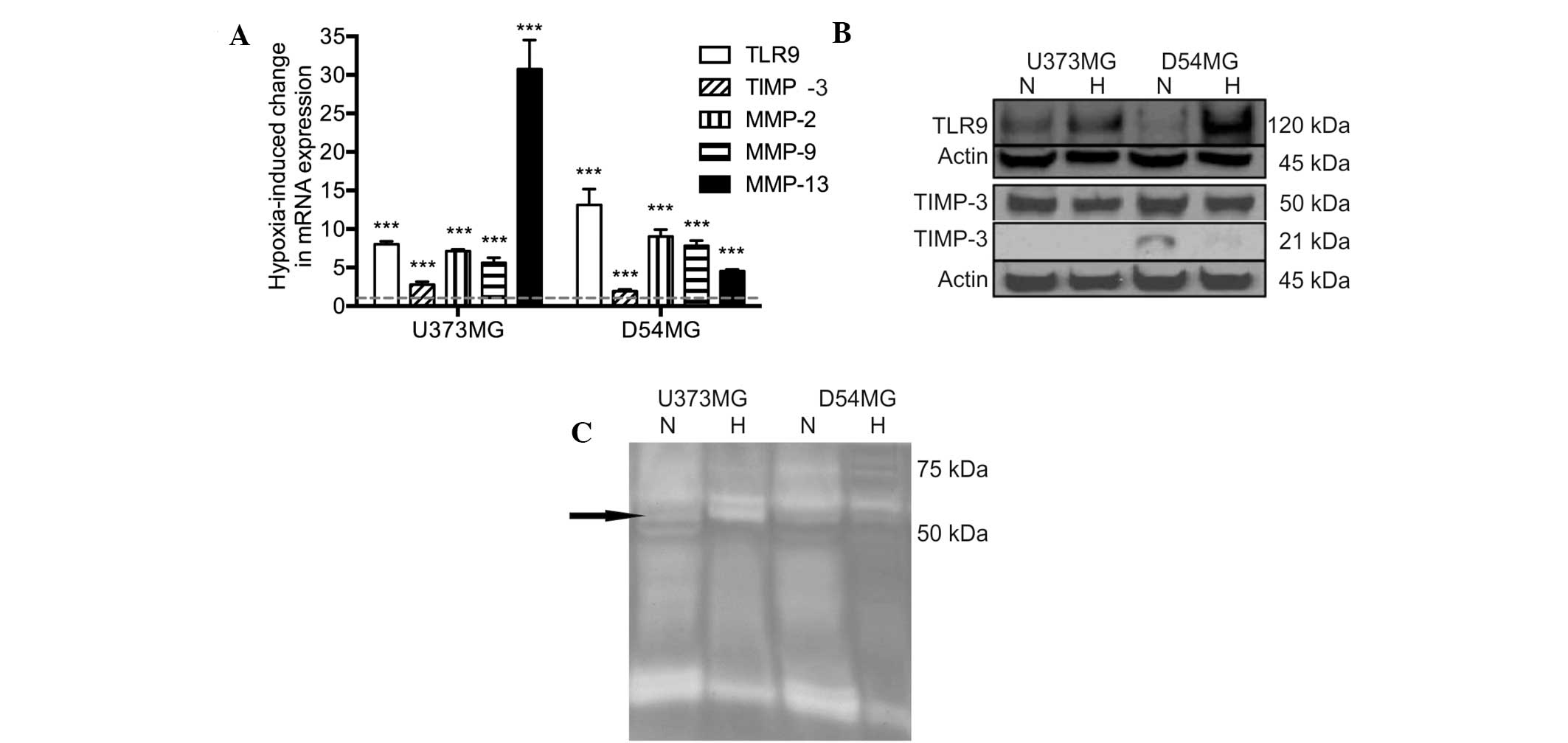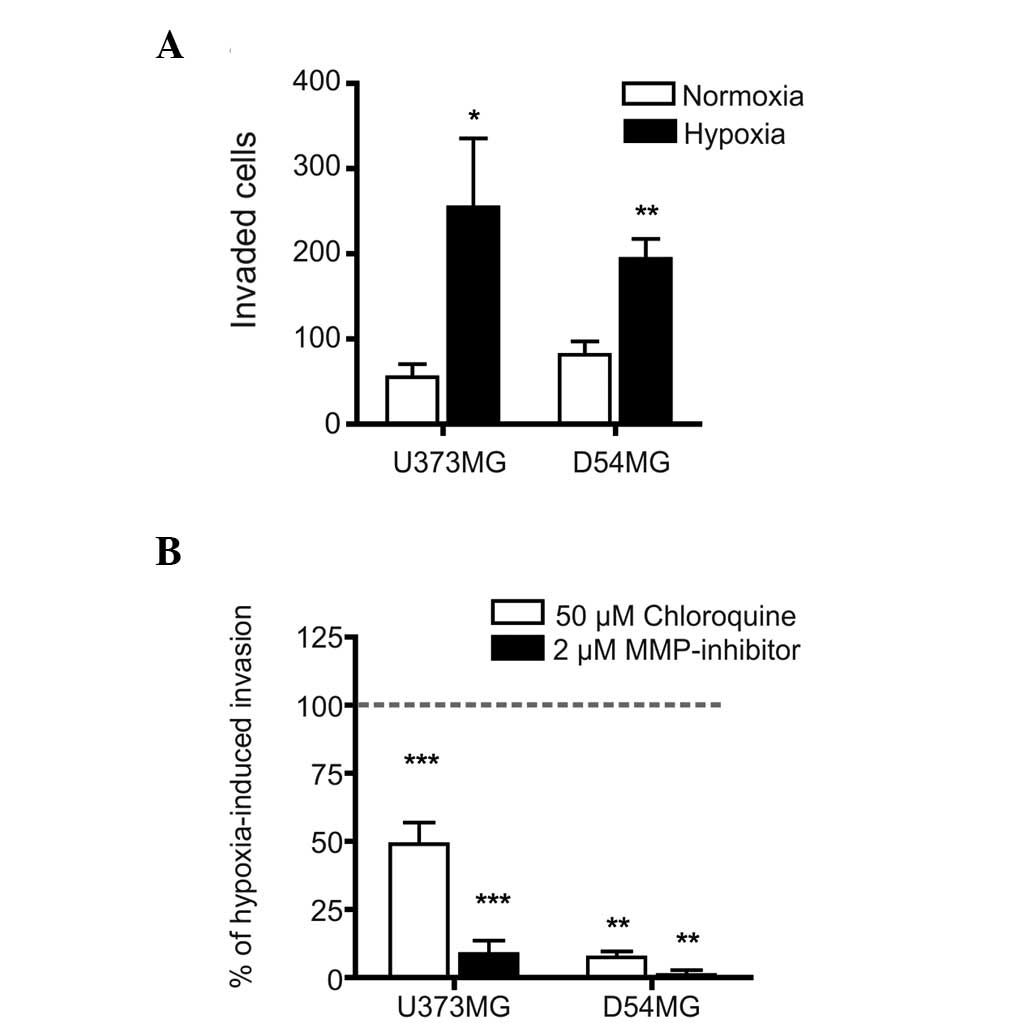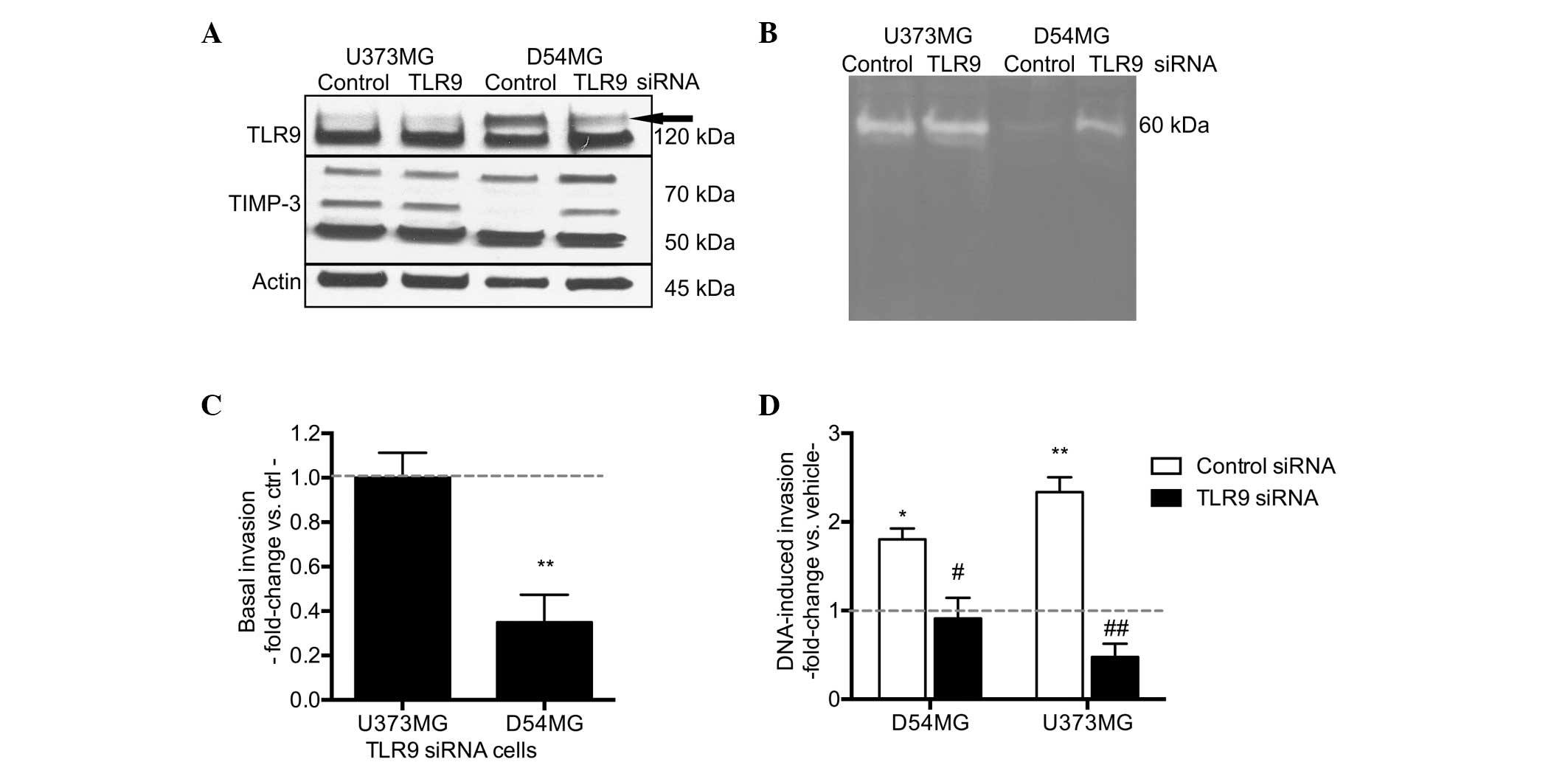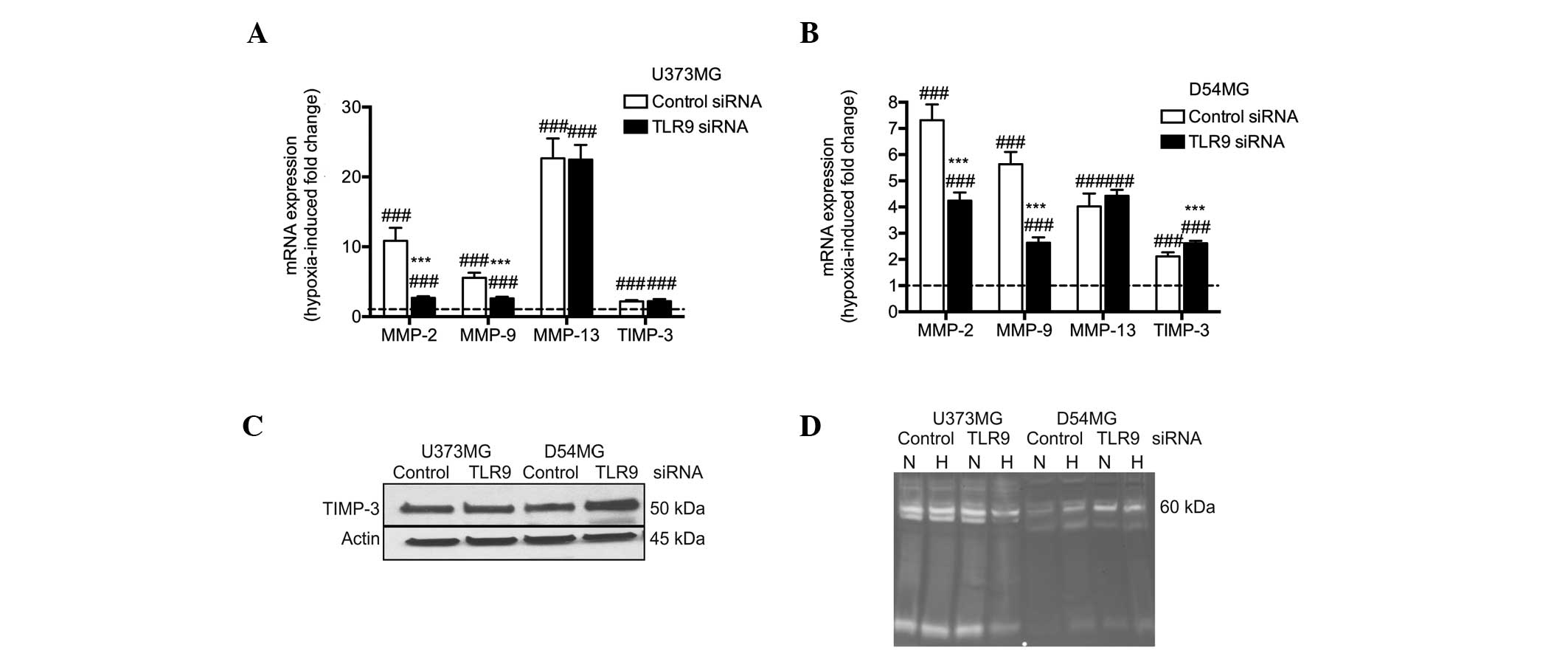Hypoxia regulates Toll‑like receptor‑9 expression and invasive function in human brain cancer cells in vitro
- Authors:
- Published online on: April 25, 2014 https://doi.org/10.3892/ol.2014.2095
- Pages: 266-274
Abstract
Introduction
The Toll-like receptors (TLRs) are key regulators of the innate immune system and function as pattern recognition proteins that detect microbe- and host-derived endogenous molecular patterns (1,2). Thus far, 13 mammalian TLRs have been identified and each TLR recognizes a specific ligand; TLR4 is the receptor for bacterial lipopolysaccharide, TLR5 recognizes flagellin and members of the TLR9 subfamily recognize RNA (TLR3, 7 and 8) and DNA (TLR9) structures (1,2). Differences have also been identified in the subcellular localization of the various TLRs; TLR1, 2 and 4 are typically cell surface bound, whereas the nucleotide-sensing receptors, TLR3 and TLR13, as well as the TLR9 subfamily, reside in the intracellular compartments (3–6). Ligand binding to TLRs activates transcription factors, most notably NF-κB and the eventual outcome of TLR activation in cells of the immune system is an innate immune reaction, which is characterized by increased cytokine and interleukin production (2). Eventually, this inflammatory reaction results in the activation of the adaptive immune system and thereby, elimination of the invading pathogens and infected cells (7).
It has been well established that in addition to the cells of the immune system, TLR9 is frequently expressed in various cancer cell lines, as well as in clinical cancer specimens (5,8–16). Furthermore, synthetic TLR9-ligands (CpG-sequence containing oligonucleotides) have been demonstrated to stimulate the in vitro invasion of TLR9-expressing cancer cells, including astrocytoma and glioblastoma cells (14,16). This increased invasion is mediated via the downregulation of the tissue inhibitor of matrix metalloproteinases-3 (TIMP-3) and the upregulation of matrix metalloproteinase-13 (MMP-13) activity (15,16). Additionally, increased TLR9 expression has been associated with the poor differentiation of cancer cells in breast, prostate and glioblastoma multiforme (GBM) tumors (17–21). Furthermore, in GBM patients, high expression of the TLR9 protein in tumors has been found to correlate with a significantly shorter survival time (17). Despite the well-documented expression of TLR9 in various cancers and invasive response to TLR9 ligands in vitro, the involvement of this protein in cancer pathophysiology remains unclear. The regulation of TLR9 expression, as well as the possible physiological ligands which may induce invasion in TLR9-expressing cancer cells, also remain poorly characterized. Synthetic TLR9 ligands have also been investigated in preclinical models of brain cancer immunotherapy; CpG-sequence containing oligonucleotides were shown to induce apoptosis in brain cancer cells in vitro and in vivo and, therefore, may provide long-term antitumor immunity against gliomas (22,23).
Hypoxia is a fundamental characteristic of solid tumors and it induces various adaptive changes in cancer cells, which eventually lead to increased tumor growth, invasion and metastasis (24). Hypoxia is also frequently detected in brain tumors and the detection of hypoxia in these tumors by hypoxia markers is essential for the diagnosis of GBM (25). Due to the previously demonstrated associations between hypoxic tissue conditions and the upregulation of TLR2 and 6 in various normal tissues, we hypothesized that hypoxic tissue conditions may activate TLR9-expression and the TLR9-mediated invasive pathway in brain cancer cells (26).
Materials and methods
Cell culture
Human D54MG, U373MG and SNB191 glioma cell lines and primary human GBM XD45 and JX10 xenolines (UAB Brain Tumor Specialized Program Of Research Excellence) were cultured in Dulbecco’s modified Eagle’s medium (Gibco-BRL, Paisley, UK) supplemented with 10% heat-inactivated fetal bovine serum, L-glutamine, penicillin/streptomycin and non-essential amino acids (all Gibco-BRL) (27,28). The cells were cultured at 37°C, in a humidified atmosphere of 5% CO2 and 95% air (~21% pO2). For the hypoxia experiments, the cells were kept for the indicated durations in a cell culture incubator (I-Glove; BioSpherix, Inc., Lacona, NY, USA) with an oxygen level set to 1 or 5% pO2, as indicated. Chloroquine was purchased from Sigma-Aldrich (St. Louis, MO, USA) and the wide-spectrum MMP-inhibitor, GM6001, was obtained from Enzo Life Sciences Inc., (Farmingdale, NY, USA).
RNA isolation and quantitative polymerase chain reaction (qPCR)
Total RNA was isolated from the cells using TRIzol reagent (Invitrogen Life Technologies, Carlsbad, CA, USA) and purified using RNeasy mini kits (Qiagen, Valencia, CA, USA). All reagents used for the qPCR experiments were purchased from Applied Biosystems (Carlsbad, CA, USA). The cDNA was synthesized from 0.2 μg of total RNA, using MultiScribe reverse transcriptase and random hexamers. TLR9 mRNA expression levels were then quantified using the following primer and probe set, obtained from Applied Biosystems: Forward, 5′-GGCCCTCCACGCATGAG-3′ and reverse, 5′-CTTGTCCTTTTCTGCCCTTGTAG-3′ for TLR9; and 5′-CCTGCAGAACTCTG-3′ for the probe. The primer and probe sets used for MMP-2, MMP-9, MMP-13 and TIMP-3 were also purchased from Applied Biosystems. For all qPCR assays, a standard amplification program was used as follows: One cycle of 50°C for 2 min; one cycle of 95°C for 10 min; and 40 cycles of 95°C for 15 sec and 60°C for 1 min. Following normalization to the large ribosomal protein RPLPO expression levels for each cDNA, a relative quantification of the target cDNA was performed using 2−ΔΔCt values (29).
Western blot analysis
The cells were cultured in normal culture medium until near confluency and then rinsed with sterile phosphate-buffered saline (PBS; Fisher Scientific, Pittsburgh, PA, USA), prior to culture in serum-free culture medium (Gibco-BRL). After 24 h, the culture medium was discarded and the cells were rapidly harvested in lysis buffer (Cell Signaling Technology, Inc., Danvers, MA, USA), prior to separation by centrifugation as previously described (30). Next, the supernatants were boiled in reducing SDS sample buffer and equal amounts of protein (~100 μg) were loaded into each lane. The samples were then electrophoresed into 10% or 4–20% gradient polyacrylamide SDS gels (Bio-Rad, Hercules, CA, USA) and transferred to nitrocellulose membranes (Bio-Rad). Following blocking with 5% non-fat dry milk in Tris-buffered saline with Tween-20 (TBST), the blots were incubated overnight at 4°C with the following primary antibodies: TLR9 (IMG-431; 1:500, Imgenex Corporation, San Diego, CA, USA), TIMP-3 (AB8106; 1:500, Millipore, Billerica, MA, USA) and actin (A-2066; 1:1,000, Sigma-Aldrich, St. Louis, MO, USA). All primary antibodies were diluted in 0.1% TBST (v/v), with 5% non-fat dry milk. The secondary detection was performed using the horseradish-peroxidase-linked secondary antibodies (NA934-100UL, Anaspec, Fremont, CA, USA) and the protein bands were visualized with Pierce Enhanced Chemiluminescence Western Blotting substrate (Pierce Biotechnology, Inc., Rockford, IL, USA) (30).
Zymograms
The cells were cultured on 12-well plates until confluent, and then washed with sterile PBS and further cultured for 24 h in serum-free media (500 μl per well). The supernatants were then collected and concentrated using a centrifugal filter device using a cut-off size of 3 kDa (UFC5-003-24; Millipore, Billerica, MA, USA). An equal amount of protein (~20 μg) was added to each lane of the zymogram gels (10% gelatin; Bio-Rad). The gels were then run, renaturated and developed using BioRad zymogram buffers, according to the manufacturer’s instructions (31).
RNA interference
Downregulation of TLR9 with siRNA was performed using a plasmid-based approach and a previously described TLR9 or control (non-targeting siRNA) siRNA sequence, which were cloned into the pSuper-EGFP vector (Oligoengine, Seattle, WA, USA) (14,31). The plasmids were stably transfected into the cells using standard techniques (14). The G418 (0.8 mg/ml) selection was maintained and four cycles of green fluorescence-based cell sorting was performed to obtain a pool of cells with a high percentage of green fluorescent protein positivity. For the U373MG cells, oligonucleotide siRNA molecules, the human TLR9 siRNA Smart pool or control human non-targeting siRNA pool (Dharmacon, Inc., Lafayett, CO, USA) were used. Briefly, 8 μl of siRNA stock (20 μM) was added to 500 μl Optimem (Gibco-BRL, Grand Island, NY, USA) on six-well plates, followed by the addition of 5 μl Lipofectamine RNAimax (Invitrogen Life Technologies, Grand Island, NY, USA). The components were mixed by pipetting and the plates were agitated on a platform for 20 min at room temperature, followed by the addition of 0.8 ml of cell suspension (45×104 cells/ml). After 2 h, 1.6 ml of regular growth medium was added to the cells and the medium was changed on the following day. After 48 h, the cells were trypsinized and subsequently used in invasion assays or cultured in serum-free media for the final 24 h in normoxic or hypoxic conditions, prior to western blot analysis.
Invasion assays
Invasion assays were performed as previously described (16). Briefly, the cells (20,000 per insert) were allowed to invade the extracellular matrix-like Matrigel (BD Biosciences, Franklin Lakes, NJ, USA) in 24-well plate inserts (Becton-Dickinson, Franklin Lakes, NJ, USA). The membranes were stained using the Hema-3 set (Thermo Fisher Scientific, Rockford, IL, USA) and the number of invading cells was counted under a microscope (Nikon Labophot-2, Nikon Instech Co., Ltd., Tokyo, Japan) (16). In certain experiments, a 22-mer DNA-oligonucleotide, which forms G-quadruplex structures (sequence, aggg tta ggg tta ggc taa ggg in a phosphodiester backbone; Midland Certified Reagent Company, Inc., Midland, TX, USA), was used as a positive control at a final concentration of 10 μM and added to the upper invasion wells. Through our ongoing studies we have determined that this DNA-ligand induces TLR9-mediated invasion (32).
Cell viability assays
In total, 20,000 cells were plated on 96-well plates (100 μl/well) in normal growth medium. The viability of the cells was measured using the CellTiter 96 AQueous One Solution Cell Proliferation assay (Promega, Madison, WI, USA), according to the manufacturer’s instructions. In an additional set of assays, the cells were plated on 24-well plates and, after the indicated time, the cells were trypsinized and the viable cells were counted using the TC10™ automated cell counter (Bio-Rad).
Statistical analysis
Data are presented as the mean ± standard deviation or mean ± standard error of the mean, as stated. Student’s t-test was used to determine whether the differences between the corresponding cells under various circumstances were statistically significant. P<0.05 was considered to indicate a statistically significant difference.
Results
Hypoxia induces TLR9 expression in human D54MG and U373MG cells
The D54MG and U373MG cells were selected for the current study as they have been demonstrated to express TLR9 and exhibit increased invasion in vitro in response to synthetic TLR9-ligands (16). Furthermore, brain cancers have been shown to be highly associated with the tumor markers of hypoxia. In the current study, the cells were cultured under normoxic and hypoxic conditions for 24 h and the mRNA expression was determined using qPCR. Hypoxia was found to induce a significant upregulation of TLR9 mRNA expression in the two cell lines. In addition, the mRNA expression levels of TIMP-3 and MMP-2, -9 and -13 were also found to significantly increase simultaneously (Fig. 1A). The protein expression levels of TLR9 were found to correlate with the mRNA levels in the two cell types. By contrast, the protein expression levels of TIMP-3 were found to marginally decrease in hypoxia in the D54MG and U373MG cells (Fig. 1B). The proteolytic activity of the conditioned medium of the U373MG and D54MG cells was analyzed using zymograms. A triple band of ~60 kDa was observed, which may present latent MMP-2 and active MMP-2 and MMP-13. Additionally, an increased level of MMP-2 activity in U373MG cells was detected in hypoxia when compared with normoxia (Fig. 1C).
TLR9 regulates MMP and TIMP-3 expression in normoxia
Hypoxia has been shown to induce invasion in various types of cancer cells (31,33,34) and, therefore, the involvement of TLR9 in the process of invasion was investigated. The invasive effects of hypoxia were first characterized in the parental U373MG and D54MG cells and, as expected, hypoxia induced a significant increase in the invasion rates of the two parental cell lines (Fig. 2A). Furthermore, the hypoxia-induced invasion of these cells was significantly inhibited by chloroquine, an important inhibitor of endosomal acidification (and, therefore, possibly TLR9 signaling) and almost completely blocked by a wide-spectrum of MMP-inhibitors (Fig. 2B). These results suggested that TLR9 signaling and MMP activity regulate hypoxia-induced invasion in these cells.
To study the involvement of TLR9 in this process more specifically, stable TLR9 siRNA cells were established, in which TLR9 expression was downregulated through a plasmid-based siRNA approach (31). In a similar manner, the control cells were transfected with a plasmid encoding a non-targeting siRNA. Characterization of the control and TLR9 siRNA cells in normoxic, steady-state conditions is shown in Table I. Briefly, relative to the corresponding control siRNA cells, the TLR9 siRNA cells exhibited downregulated TLR9 mRNA expression levels of ~37 and ~66% in the U373MG and D54MG cells, respectively. Furthermore, the downregulation of TLR9 induced cell-specific changes in cellular MMP and TIMP-3 mRNA expression levels. The mRNA expression levels for various MMPs (MMP-2, -9 and -13) remained unchanged or were marginally upregulated in the two cell lines; however, downregulation of TLR9 resulted in a significant upregulation of TIMP-3 mRNA expression (Table I.).
Table IBasal mRNA expression in the TLR9 siRNA cells relative to the corresponding control siRNA cells in normoxia. |
At the protein level, the changes in TLR9 expression between the control and TLR9 siRNA cells in normoxia were subtle and similar to that of the mRNA expression (Fig. 3A). Consistent with the changes at the mRNA level, D54MG/TLR9 siRNA cells also exhibited increased TIMP-3 protein expression; however, this upregulation was particularly detected in TIMP-3 protein bands of high molecular weight, which may subsequently present different glycosylation forms of the protein (35,36). In the U373MG/TLR9 siRNA cells, TIMP-3 protein expression in normoxia was similar to that of the U373MG/control siRNA cells (Fig. 3A). A comparison of the proteolytic activity between the control and TLR9 siRNA supernatants in normoxia demonstrated differences between the control and TLR9 siRNA D54MG cells. More specifically, the supernatants of the D54MG/TLR9 siRNA cells exhibited enhancement in a 60-kDa proteolytic band, suggesting an increase in latent MMP-2 (Fig. 3B). No such differences were detected between the proteolytic activities of the U373MG control siRNA and TLR9 siRNA supernatants in normoxia. The basal invasive capacity of D54MG/TLR9 siRNA cells in normoxia was significantly decreased, as compared with the D54MG/control siRNA cells. However, no difference was detected between the control and TLR9 siRNA U373MG cells (Fig. 3C).
Finally, to further confirm the differences in TLR9-mediated invasion between the control and TLR9 siRNA cell pairs, the invasive capacity of these cells was also studied in response to treatment with G-quadruplex-DNA TLR9-ligands in normoxia. As compared with the vehicle, the G-quadruplex-DNA induced an approximately two-fold increase in invasion in the D54MG/control siRNA cells, but not in the corresponding TLR9 siRNA cells. Similar results were observed with the stable U373MG cells, confirming differences in the TLR9-mediated invasive responses of the TLR9 siRNA cells (Fig. 3D).
Overall, these results suggest that the downregulation of TLR9 in brain cancer cells results in decreased basal and DNA ligand-induced invasion in normoxia, in a cell-specific manner. The anti-invasive phenotype, particularly of the D54MG/TLR9 siRNA cells, suggests that despite the observed increases in MMP mRNA expression, the increased expression levels of the endogenous MMP-inhibitors, such as TIMP-3, are possibly a more significant determinant of their invasive behavior in normoxia.
Hypoxia-induced invasion is inhibited in TLR9 siRNA brain cancer cells
Next, the involvement of TLR9 in hypoxia-induced invasion was studied more specifically, using the D54MG and U373MG control and TLR9 siRNA cells. As with the parental cells, hypoxia induced TLR9 mRNA expression in the control siRNA cell lines, as well as in the TLR9 siRNA cells. The hypoxia-induced increases in TLR9 mRNA expression were, however, significantly reduced in the TLR9 siRNA cells (Fig. 4A). As predicted, TLR9 protein expression levels were also found to decrease under hypoxic conditions in the two TLR9 siRNA cells, when compared with those of the control siRNA cells (Fig. 4B). Invasion assays were also used to study these cells; hypoxia induced an increased level of invasion in the control siRNA cells, however, invasion was evidently reduced in the TLR9 siRNA cell lines (Fig. 4C). In an attempt to achieve an improved level of TLR9 protein downregulation, TLR9 expression was also downregulated in the U373MG cells using an oligo siRNA approach. With this approach, the U373MG cells transfected with the TLR9 siRNA molecules demonstrated a complete loss of hypoxia-inducible TLR9 protein expression (Fig. 4D). Similar to the results obtained with the plasmid-based siRNA, the oligo TLR9 siRNA U373MG cells also demonstrated a significantly inhibited response to G-quadruplex-DNA and hypoxia-induced invasion, as compared with the corresponding control oligo siRNA cells (Fig. 4E). In conclusion, these results suggest that the downregulation of TLR9 expression inhibits the hypoxia-induced invasion of brain cancer cells in vitro.
Finally, the effect of hypoxia on TLR9 expression and invasion was investigated in other cell lines. Consistent with the previously described observations, hypoxia increased invasion in the SNB191 glioma cells, whereby the TLR9 protein was also observed to be upregulated (Fig. 5A and B). By contrast, invasion was not upregulated by hypoxia in the primary JX10 and XD45 glioma cell lines, where the protein expression of TLR9 was not found to increase, or to be downregulated by hypoxia (Fig. 5A and B). Therefore, these results suggest that TLR9 mediates hypoxia-induced invasion in brain cancer cells in vitro.
TLR9 regulates MMP and TIMP-3 expression in hypoxia
Next, the mechanisms that may explain the TLR9-mediated invasion in hypoxia were investigated using control and TLR9 siRNA D54MG and U373MG cells. Firstly, the hypoxia-induced fold changes of selected mRNAs versus normoxia between the corresponding control and TLR9 siRNA cells were compared. Relative to normoxia and similar to the parental cells, hypoxia induced significant increases in MMP-2, -9 and -13 expression in the two control siRNA cells. With the exception of MMP-13 mRNA, the hypoxia-induced changes were TLR9-dependent and significantly reduced in the two TLR9 siRNA cell lines. Furthermore, similar to the parental cells, hypoxia also induced TIMP-3 mRNA expression in the two control cell lines, and this effect was significantly enhanced in the D54MG/TLR9 siRNA cells. In the U373MG/TLR9 siRNA cells, hypoxia-induced effects on TIMP-3 mRNA expression were similar to those detected in the control siRNA cells (Fig. 6A). These changes in TIMP-3 mRNA expression were also found to correlate with the TIMP-3 protein expression levels; TIMP-3 protein expression was found to be similar in U373MG/control siRNA and TLR9 siRNA cells in hypoxia. However, in the D54MG/TLR9 siRNA cells, TIMP-3 protein expression levels were increased compared with the levels observed in the corresponding control siRNA cells in hypoxia. In contrast to the normoxic conditions, the change in the TIMP-3 expression level was detected as a ~50 kDa band (Fig. 6C). Zymograms of the supernatants of the corresponding cells further indicated a decreased induction of proteolytic activity by hypoxia, particularly in the U373MG/TLR9 siRNA cells. Among the D54MG cells, hypoxia-induced proteolytic activity was observed in the control siRNA cells, but not in the corresponding TLR9 siRNA cells (Fig. 6D). Therefore, these results suggest that hypoxia-induced proteolytic and invasive activity is mediated by TLR9 in D54MG and U373MG cells, possibly via the regulation of MMPs and their endogenous inhibitors.
Discussion
TLR9 is an innate immunity receptor, which recognizes self- and microbe-derived DNA (37,38). Although widely expressed in various tumors, including brain cancer, the contribution of TLR9 to cancer pathophysiology remains unclear (16,39) and the regulation of TLR9 expression in cancer is also poorly understood.
The present study demonstrated that the surrounding oxygen level has an important effect on TLR9 expression and function in human brain cancer cells in vitro. In addition, our studies further suggest that TLR9 expression is significantly associated with the invasive machinery in brain cancer cells and may mediate hypoxia-induced invasion in brain cancer. This novel observation may have therapeutic implications in brain cancers, particularly for those tumors that exhibit high hypoxia-associated TLR9 expression at diagnosis. The marginal changes in TLR9 expression observed in the TLR9 siRNA cells in normoxia, which appear to regulate MMP and TIMP-3 expression, suggest that TLR9, as a DNA-binding protein, may exhibit transcriptional activity. However, this hypothesis requires further study. Although hypoxia also induces TLR9 expression in breast cancer cells, we previously demonstrated, particularly in triple-negative breast cancers, that decreased TLR9 expression does not inhibit hypoxia-induced invasion but rather augments it. This effect was associated with a complete lack of TIMP-3 expression and was not detected in breast cancer cells that express the estrogen receptor (31). Overall, these observations suggest that, although hypoxia appears to regulate TLR9 expression in various cancer cells, the effects of TLR9 inhibition on hypoxia-induced invasion are specific to cancer type. This is to be expected, as it was recently demonstrated that TLR9 may utilize as many as 190 different cofactors to facilitate various cellular responses (40).
Hypoxic tumor regions are common in brain cancer, including GBM, and thus hypoxia is used as diagnostic criteria (41). Increased tumor hypoxia is also associated with poor prognosis in GBM, as hypoxia is important in GBM invasion (42,43). The less invasive phenotype of TLR9 siRNA cells in normoxia and hypoxia suggests that TLR9 may mediate the high levels of brain cancer cell invasion into the healthy brain tissue in clinical tumors, through regulation MMP expression and activity. Notably, hypoxia has also been shown to activate MMP-2, -9 and -13 in brain tissues; however, the current study is the first to demonstrate that these proteases may be TLR9-regulated in brain cancer cells (42,44). The results from a previous study suggesting that the absence of TLR9 expression protects against ischemia-reperfusion injury in the liver also imply that hypoxia-induced changes may be TLR9-mediated in other tissues (45). Furthermore, since the procedures of the current study were performed without the addition of exogenous ligands, the results additionally suggest that TLR9 expression is sufficient to control cancer cell invasion. However, the presence of TLR9 ligands can not be ignored, since apoptotic DNA and other endogenous ligands have been demonstrated to stimulate TLR9 expression in mammalian cells and, therefore, may have been present under the experimental circumstances (38,46). These observations add TLR9 to the list of molecules that have been previously suggested to mediate hypoxia-induced invasion, including MMP-2, Jagged-2, vascular endothelial growth factor, fibroblast growth factors and semaphorin 3F (47,48).
Hypoxia-inducible factor (HIF)-1 is a major regulator of hypoxic responses in cells, that comprises of two subunits (HIF-1α and HIF-1β), which binds to hypoxia responsive elements upstream of the hypoxia-regulated target genes (49). HIF-1α is particularly responsible for the cellular changes in acute hypoxia and, furthermore, HIF-1 expression has been detected in clinical cohorts of glioma; inhibition of HIF-1α expression reduces hypoxia-induced invasion in glioma cells in vitro and in vivo. An association has been established between HIF-1α and TLRs, as stimulation with TLR ligands has been shown to result in the accumulation of the HIF-1α protein, or to result in cellular responses that are mediated by HIF-1α (50,51). However, hypoxia has also been shown to upregulate TLR2, 4, 6 and 9 via HIF-1α (26,31,52). The reciprocal interaction between TLRs and HIF-1α suggests that hypoxia-induced TLR9 expression may also be HIF-1α-regulated in brain cancer cells. A recent study by Sinha et al further suggested that such regulation may also occur in states other than hypoxia (53); however, further study is required to confirm these theories.
In conclusion, hypoxia regulates TLR9 expression in brain cancer cells in vitro and TLR9 also mediates the hypoxia-induced invasion of these cells. Overall, these observations suggest that TLR9 expression may contribute to the increased invasion of brain cancer cells under hypoxic tissue conditions. Although this phenomenon requires further study in vivo, the results of the current study suggest that the suppression of TLR9 expression and activity may present a novel molecular target in brain cancer.
Acknowledgements
The authors would like to thank Ms Christine Pressey for skillful assistance with the qPCR assays. The present study was funded by grants from the Oulu University Scholarship Foundation and Cancer Foundation of Northern Finland (J.H.K.), the Lapland Cultural Foundation (K.S.S.) and the Department of Defense (K.S.S. and D.G., grant no. BC095831).















